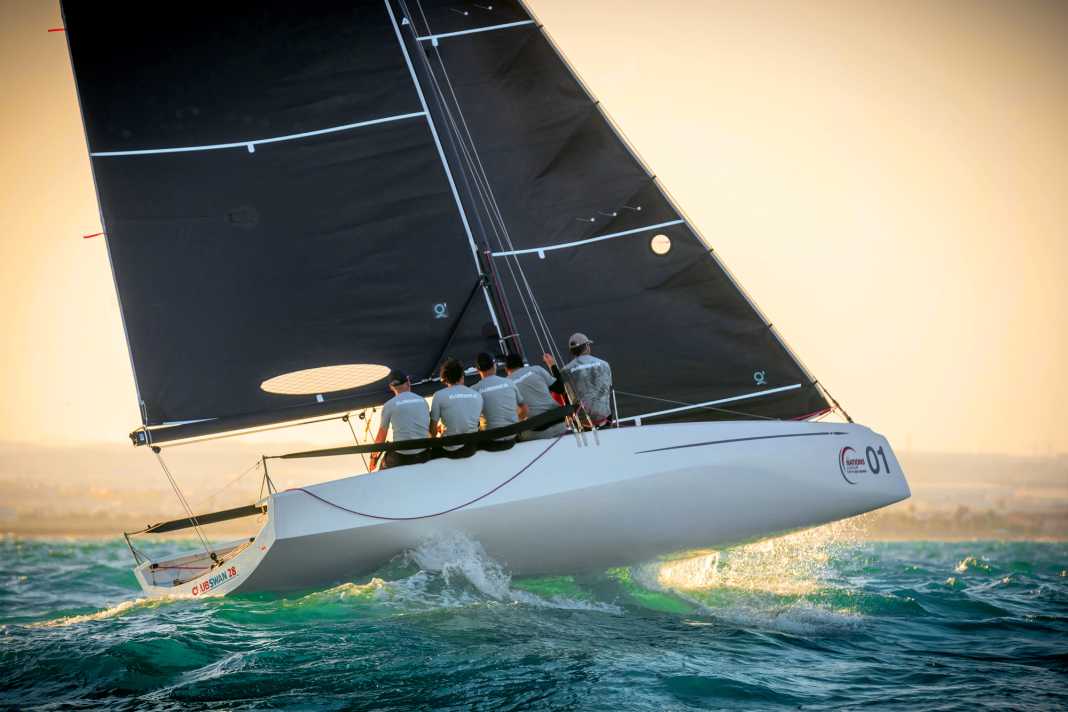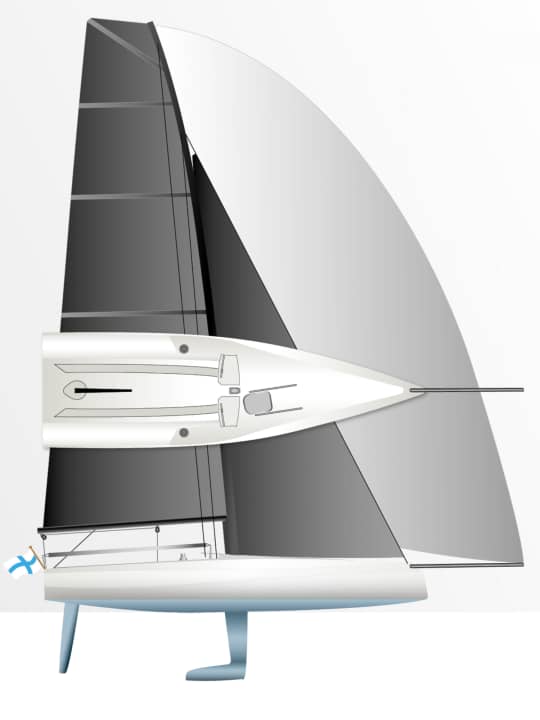





- Attractive athlete with easy handling
- Ideal for road transport to the regatta
- Strong sales ensure speed
- High class has its price
- A success in its first year
- The measured values for testing the ClubSwan 28
- The ClubSwan 28 in detail
- Equipment, prices and shipyard
- YACHT rating of the Clubswan 28
Many manufacturers are striving for it: the ultimate one-design sports boat as a magnet for ambitious regatta sailors who want to sail in large fields and at a high, competitive level against the best and best known on the international regatta scene. Those who succeed in meeting this demand with a well thought-out and promising concept may have a real self-runner on their hands right from the start.
Of course, this is not easy. Many shipyards and brands have already cut their teeth trying to create the perfect one-size-fits-all racer. And all too often the plan has failed miserably. Not least because of the competition. Only a few models have made the breakthrough internationally. Good examples are the Melges 24 or the J/70, which, even after many years on the market, present themselves as strong, successful standardised classes with large fields of participants worldwide.
Attractive athlete with easy handling
Now a big, legendary name in yacht building also wants a slice of the cake. Nautor Swan in Finland has now unveiled the brand new ClubSwan 28, the smallest boat the shipyard has ever built. And the small Swan is now set to enable the rapid development of a standardised class with international distribution. Federico Michetti is responsible for the ambitious development of the sporty Club Swan programme at Nautor. The regatta professional from Italy has already coordinated the development of the Melges 24, 20 and 32 classes in Europe for the Americans from Melges Boatworks and crowned them with numerous world championship titles.
Nautor has impressively demonstrated that this can be achieved with the larger ClubSwan 36. YACHT has also tested these. This class has already established itself internationally with a highly competitive regatta circuit. However, the 36 is a very complicated and extremely demanding boat that is sailed with foils, which is not the only reason why it requires professional skills. In comparison, the new, smaller ClubSwan 28 should be no less attractive in sporting terms, but easier to handle and also easy for amateur teams to master.
The Argentinian yacht architect Juan Kouyoumdjian (Juan Yacht Design) has supplied the design plans for all current ClubSwan yachts for Nautor, including the 28, of course. His signature on the smallest boat in the series is unmistakable. This is characterised by the strongly pronounced deck bulge, the canoe-like bow with negative stem, the hard-set and continuous chine edges and the concave hull flanks at the stern.
Ideal for road transport to the regatta
Nevertheless, compared to the larger ClubSwan 36, the design of the smaller boat is now significantly less radical, especially below the waterline. Here, the 28 shows a more conventional lateral plan with a slim L-keel, a manageable, inland-suitable draught and a deep, also rather lean-profiled single rudder.
The designer thus fulfils the requirement that the ClubSwan 28 - as is usual for sports boats of this size - can be transported easily and simply on a road trailer, for example to follow the international regatta circuit in the future. With a ready-to-sail total weight of just 1.2 tonnes and a width of 2.50 metres, this is even possible without a special permit. In addition, the draught can be reduced from 1.8 metres to less than 1.0 metres thanks to a lifting keel. The rudder blade is also mounted in a cassette with roller bearings and can be removed in a few simple steps. This means that the boat is at maximum depth for road transport and can also be lowered in and out of the water via a slip ramp. For transport over longer distances or overseas, the ClubSwan 28 with the entire rig fits easily into a 40-foot container.
Strong sales ensure speed
Construction number one is available to YACHT for a test on Lake Garda. Unfortunately, the wind conditions on the test day are not what the northern Italian wind machine is known for. In the afternoon, there was only a light southerly wind blowing at a maximum of ten knots. The lightweight can be steered sensitively and moves spiritedly upwind. The performance values on the wind at 3 Beaufort: 6.4 knots at an angle of 40 degrees.
For the downwind course, an almost 90 square metre gennaker is pulled up to the masthead. The large bladder ensures a strong turnover and the log quickly shows over nine knots of speed. The trunk extends centrally out of the bow and protrudes a maximum of 2.20 metres beyond the tip of the bow. This means that the gennaker can easily be jibed through the inside, i.e. around the forestay. And the 106 per cent overlapping genoa can remain in place on the downwind course without affecting the flow of the gennaker.
The ClubSwan 28 is built by SRG (Sinergia Racing Group) in Spain. The hull and deck are manufactured there using the weight-saving vacuum infusion process as a sandwich construction made of E-glass, vinyl ester resin and foam core. The solid floor assembly is also built using the infusion process and subsequently bonded to the hull. The carbon fibre rig (high modulus) comes from Axxon Composites and is fitted with lightweight and extremely stiff PBO shrouds as standard. Instead of shroud tensioners, a hydraulic system at the foot of the mast ensures sufficient rig tension. Incidentally, the mast is on deck and can be easily raised and lowered by hand.
High class has its price
The very stringent class rules allow a limited wardrobe for regattas with one mainsail, two headsails and two gennakers (reacher and VMG). Cloth weights and sail areas are fixed, but not the manufacturer. This leaves room for the development of new profiles and technologies, which makes the class attractive. The class rules also impose no restrictions on the crew (weights, professionals). The ClubSwan 28 is usually sailed with a crew of five. However, the number of crew members is regulated. No more than two people are allowed to sail with their legs outboard. This is intended to restrict extensive hiking, i.e. riding over the railing.
Motorisation with a 6 hp outboard motor is also mandatory. This makes sense, as the very slim hull appendages mean that the boat is hardly really manoeuvrable in the harbour, at least under sail. During the regatta, the engine is safely stowed in a watertight storage compartment under the cockpit floor. There is no cabin superstructure. This leaves the deck completely free for an optimal arrangement of all functions for trimming the sails. The cockpit is huge and well organised into the individual work areas. The high-quality equipment with the best fittings from Harken and Dyneema rigging ensures smooth manoeuvres. The gennaker is set and recovered by a so-called launcher.
The disillusionment comes with the price. Nautor is asking a good 260,000 euros gross for the ClubSwan 28 including carbon fibre mast, textile rigging and top equipment. By the time it reaches the starting line, another 40,000 euros will have been added for a complete set of sails and at least 5,000 euros for the electronics. A road trailer costs 14,000 euros. So if you want to bring a ClubSwan 28 to the starting line ready to race, you have to reckon with total costs of around 330,000 euros. Ambitious regatta sailors treat themselves to this exclusive package and secure their participation in high-class regatta sport with the ultimate in uniformity without any commercial advantages.
A success in its first year
Shortly after the market launch, the first ClubSwan 28 boats to be built took part in international class regattas. At the prestigious Rolex Swan Cup in Porto Cervo in September, for example, five teams were already at the start on their brand new boats. Seven teams from Japan, the USA, Italy, France, Monaco and Switzerland have already taken part in the Swan Villasimius Challenge. And this is set to continue next year. The ClubSwan 28 will be included as a new class in the Swan Racing Nations League. Organiser Federico Michetti is expecting up to 20 participating boats by the end of the 2025 season, with a total of seven top-class regatta events planned for the ClubSwan 28, 36, 42, 43 and 50 classes throughout Europe.
The measured values for testing the ClubSwan 28



The ClubSwan 28 in detail

- Designer: Juan Kouyoumdijan
- CE design category: C
- Torso length: 8,50 m
- Total length: 10,70 m
- Waterline length : 8,50 m
- Width: 2,50 m
- Depth: 1,80 m
- Draught keel caught up: 0,95 m
- Mast height above WL: 12,90 m
- Theor. torso speed: 7.1 kn
- Weight: 1,2 t
- Ballast/proportion: 600 kg/50 %
- Mainsail: 30,2 m2
- Furling genoa (106 %): 18,5 m²
- Gennaker (top): 87,0 m²
- Bowsprit length: 2,20 m
- Machine (exterior): 6 HP
Hull and deck construction
Hull and deck built as E-glass sandwich laminate with foam core and epoxy resin. The keel shaft is made of aluminium, the ballast bomb of lead.
Rig
The carbon fibre mast (high modulus) comes from the manufacturer Axxon Composites. The standing rigging (all shrouds and stays) is made of PBO. This is part of the standard equipment. A hydraulic system below deck ensures sufficient rig tension.
Sail
The owner chooses the manufacturer for the sails. A competitive set of sails for regatta use (one mainsail, two jibs, two gennakers) costs around 40,000 euros gross.
Equipment, prices and shipyard
- Base price ex shipyard: 261.800 €
- Price ready to sail: 288.490 €
- Guarantee/against osmosis: 2/2 years
As of 01/2025, how the prices shown are defined, read here!
Shipyard
OY Nautor AG, Nautor Swan; 68600 Pietarsaari (Finland); www.nautorswan.com
Distribution
Nautor Swan Germany; Hamburg; www.nautorswan.com
YACHT rating of the Clubswan 28
With the smallest Swan ever built, the legendary Nautor shipyard is seeking to enter the world of handy and trailerable sports boats. The exciting One design is very attractive, but the high price is painful.
Design and concept
Modern design
Ultimate unity class
Easy to transport
Participation in Swan regattas
Expensive in comparison
Sailing performance and trim
High performance potential
Best trimming facilities
Long, extendable bowsprit
Manoeuvrability in port
Equipment and technology
High-quality basic equipment
Carbon rig and textile shrouds
Hydraulics for rig tensioning
Flexible fuselage attachments

